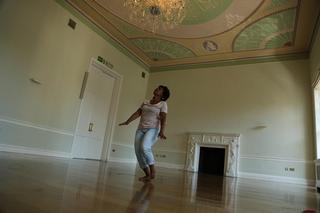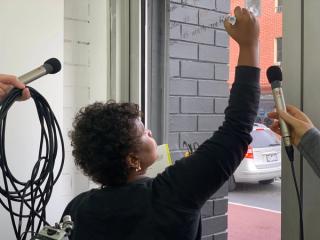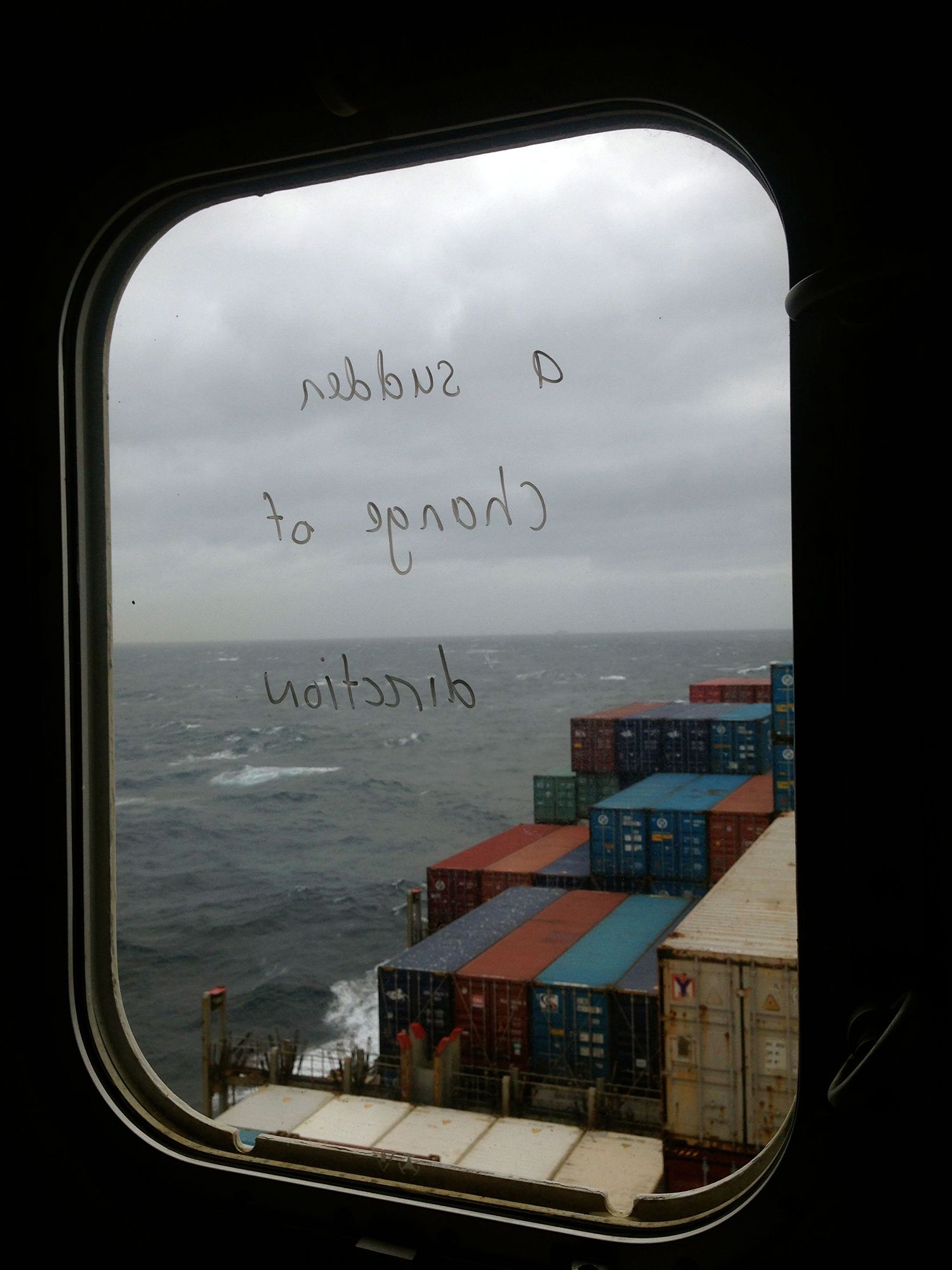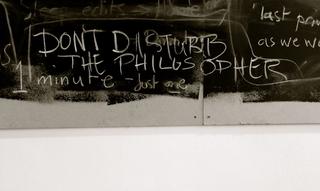

Regional Art + Research Residency: Amaara Raheem
Amaara Raheem
2–23 May 2022
Sadly I cannot be at Mooramong for the new dates in May 2022. I have been so looking forward to visiting / being on site but I'm grateful that this residency can accommodate an online-hybrid practice. I continue to work with the framework of 'listening-in', with particular attention to my site-specific practice of collecting words and gestures. I will develop a glossary / dictionary of terms for site-specific dance practice. This is a beginning to understand a practice for working in and with a site, where site is considered as both place and space; as a framework, an approach or a way of living (dancing). This dictionary is a beginning not an end. It proposes not fixed definitions but strategies and scores for working with site as a space for undoing; site as collaborator and ally.
‘Listening-in’ (working title) investigates processes of listening – with my whole body - on site at Mooramong. I’m inspired by the framework of ‘eavesdropping’ developed by artists Rebecca Collins and Johanna Linsley as method and material to approach a new place, make connections, try to understand the systems and dynamics and resources and struggles that make this place specific, and try to contribute to the modes of potentiality and inventiveness and imagination that I might find there. “Eavesdropping” write Collins and Linsley, “is about overhearing or the layers we add to everything we hear – the biases and associations that help us construct identities for the people, places and things that surround us”.
Each day I begin with movement, a daily practice of dancing, working with scores. I return to places within the site (both indoors and outdoors) and repeat certain tasks such as, making physical contact with trees, earth, walls, stairs, fences, grass, roots, corridors, windows; dancing in relation to certain rooms or certain weather; going for long walks around the farm; stopping and talking to people I meet. If I find something edible on site, I will eat it. Picking up fallen flowers I press them in books and then examine in great detail the ways in which they stained the page. At night, I track the phases of the moon and keep a dream diary. These are some of the ways in which I’ll take on the persona of a detective on a mission to find the not-yet-always.
To become a detective is to develop a fictional construct that performs a back and forth between first and third person. This interplay between narrative points of view is to address the role of imagination, vocalisation and fiction in my dance practice. Finally, this residency is about being ‘in-residence’. Living in Mooramong in an immersive context is an opportunity to explore moving, writing, thinking and listening in/on site. In-residence allows me to draw on inheritance, iteration, memory and myth and more importantly, to remember that this historic ‘home’ is an activity contingently produced, where the private and the public body come into conversation and play in unstable (and perhaps uncomfortable) ways.
.
Initially I proposed a project ‘Listening-in’ (working title) that investigated eavesdropping, on site at Moormanong. I gave myself the framework of eavesdropping to approach a new place, make connections, try to understand the systems and dynamics and resources and struggles that make this place specific, and try to contribute to the modes of potentiality and inventiveness and imagination that I find.
As it turned out, I never went to Mooramong due to lockdowns and other events, and I did my residency at home. Listening-in was still a key aspect to this residency, although it pivoted to something more imaginary and textural than site-responsive. I spent time listening to conversations - with colleagues and collaborators - recorded during lockdown. These conversations were in relation to place, identity and belonging. I spent time transcribing, editing, writing and rewriting. Out of this process, a script emerged, for five voices.
.
In my practice, writing sits alongside movement. In movement I began to follow lines in space, in memory, in my body, in architecture, in time. This combination of writing a script and moving lines gave way to thinking of the possibilities of making a dance for headphones; a dance as listening-in, rather than acts of looking.
I invited composer and musician Nat Grant to come into the studio one afternoon, and record the movements she heard. This included dancing and writing on windows - a practice I’ve been working with for a long while. Nat mixed the recordings into an experimental test, and it really feels to me that this has potential to grow in all kinds of ways.
.
This online residency gave way to writing, mark making, tracing, drawing, moving, breathing - rhythmic structures found by listening. Writing was also rhythmic and proposes its own kind of listening-in.
What developed in this online residency was a new line of enquiry - sonic choreographies - in which my body becomes a multi-channel soundscape system. I would like to further explore how to make a dance for the ears.
.
Amaara Raheem, aural choreography test with composer / musician Nat Grant, 2022, 3:11min. Courtesy the artists.
.
She took herself seriously. Her bedroom has new smells for her. She opened all her boxes. There were two and inside those two, there were two more. In residence is never an easy situation. There was something like tentativeness in the air. There was something like the feeling of Autumn in the air.
In one of the boxes she finds an object - a word - amrit - which means ‘nectar’ in Sanskrit: the sweet syrup the gods of India are always drunk on.
Immortality is just a word; a word that shines, like brass. Polished by the hands of her mother and her grandmother and her mother before her.Amrit अमत. A drink, a miracle, a medicine, a red body. She drank the holy water, and journeyed on. It was sweet and bitter at the same time.
When she arrived in residence there were all kinds of rooms inside this space. And all rooms were not the same. Some better than others, she thought. A better view, a better layout. Better shower, harder mattress
She put her hand in her pocket and found a netsuke. A hare with amber eyes carved in ivory. To the rising merchant class of Japan, who were not allowed to wear jewellery, the netsuke were once indispensable. That is, until the introduction of the cigarette when this miniature art became obsolete. And like the cigarette, the netsuke fit so neatly into the palm of one’s hand. It pulled her into the world within a word, with a centrifugal force.
Suddenly, a knock on the bedroom door. She opened the door and there was nobody there. There was a box on the ground. Is this Pandora’s box, she thought: better left untouched?
She opened the box and pulled out a telephone. She listened to the silence of the telephone in her hands. And then she put the receiver down. Very dramatic.
Every Friday, when she was a child, she’d go with our father to somebody’s house, and hear the Uncles share the stories of the Ramyana, and she didn’t really understand what was happening, only that she didn’t like hot and crowded rooms. Then she grew up, left home, and did other things, and periodically came back. One day, dressed in a sari, she sat on the floor of a crowded house and listened again to the old stories, and understood. She finally met the material of the words, and the old stories told us to stop chasing ideas. Rather, to wait for them to appear. To not plan the stories she wants to tell but to find them.
The ancient world is orderly, not chaotic. Its order is not imposed by humans. The true laws - ethical, aesthetic, scientific - are not imposed by any authority - above or below - but exist in things, and are to be found by listening.
The phone rang. Somewhere in another room, in another time-zone, was another bed. Somebody got up and phoned her. It happens all the time, really. A kind of reaching out, for somebody else’s voice.
The person on the telephone was her Astrologer, calling from Brooklyn.
Her astrologer said, it’s the waning crescent. Her astrologer said, the moon is in Aquarius.
Her astrologer said it's a good day for taking strolls.
Her astrologer said, you are two ends of the same concept. You are your body dwindling and melting away.






Blindside has facilitated a number of residency projects that foster engagement with regional Victoria, encouraging artists to grow connections between their practice, the environment and community.
In 2018 Blindside partnered with the National Trust to offer the inaugural Regional Art + Research Residency at Mooramong, which aims to bring distinct, contemporary and creative voices to a heritage site and to support the development of new work and thinking.
Two Melbourne-based artists – Klari Agar and Lisa Lerkenfeldt – and two artists based in regional Victoria – Amaara Raheem and Caitlin Royce will undertake artist-driven residencies at Mooramong from 2 - 23 May 2022.
Supported by the Victorian Government through Creative Victoria and the City of Melbourne.
Amaara Raheem is a choreographer and performer. Her work takes multiple forms including performance, video, installation, text and sound. Recently Amaara was awarded a Responsive Residency (Critical Path, 2021) with dancer Preethi Athreya (Chennai) to investigate notions of inheritance. Amaara co-curates Now Pieces (Dancehouse, 2021), a regular platform for improvised performance and Organising For Change (Dance Art Foundation, 2021), a series of online events with and for artists and community organisers. Amaara sits on the Artistic Advisory Group for Chunky Move and Next Wave.




